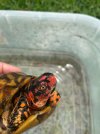
Hi everyone at TFO.
I came across the above, which attracted my attention immediately when I saw that cute tort/turtle. After having read the words, I hesitated for a moment and thought: "There's a lot of truth in what that poor tort said, as far not wanting to be "rescued" and consequently "imprisoned" by anyone. Moreover, he/she went on to say: I am not a pet....." And: "Please leave me alone so that I can stay free."
I would like to ask: how many of you agree with the above tortoise and how many disagree, no matter how much care you are taking of your pet? Personally speaking, and honestly speaking, I believe that there is a lot of truth there, sadly.
I'd like to hear your opinions, asap: the matter is somewhat worrying me after I read those words.
Thank you.
